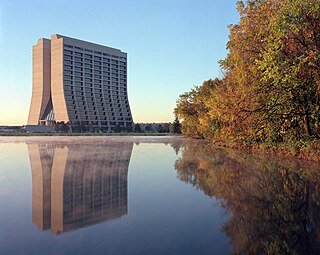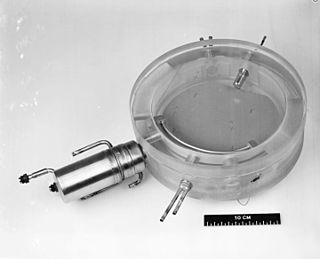
Donald Arthur Glaser was an American physicist, neurobiologist, and the winner of the 1960 Nobel Prize in Physics for his invention of the bubble chamber used in subatomic particle physics.
In experimental and applied particle physics, nuclear physics, and nuclear engineering, a particle detector, also known as a radiation detector, is a device used to detect, track, and/or identify ionizing particles, such as those produced by nuclear decay, cosmic radiation, or reactions in a particle accelerator. Detectors can measure the particle energy and other attributes such as momentum, spin, charge, particle type, in addition to merely registering the presence of the particle.

A cloud chamber, also known as a Wilson cloud chamber, is a particle detector used for visualizing the passage of ionizing radiation.

Gargamelle was a heavy liquid bubble chamber detector in operation at CERN between 1970 and 1979. It was designed to detect neutrinos and antineutrinos, which were produced with a beam from the Proton Synchrotron (PS) between 1970 and 1976, before the detector was moved to the Super Proton Synchrotron (SPS). In 1979 an irreparable crack was discovered in the bubble chamber, and the detector was decommissioned. It is currently part of the "Microcosm" exhibition at CERN, open to the public.
A wire chamber or multi-wire proportional chamber is a type of proportional counter that detects charged particles and photons and can give positional information on their trajectory, by tracking the trails of gaseous ionization.

The UA1 experiment was a high-energy physics experiment that ran at CERN's Proton-Antiproton Collider, a modification of the one-beam Super Proton Synchrotron (SPS). The data was recorded between 1981 and 1990. The joint discovery of the W and Z bosons by this experiment and the UA2 experiment in 1983 led to the Nobel Prize for physics being awarded to Carlo Rubbia and Simon van der Meer in 1984. Peter Kalmus and John Dowell, from the UK groups working on the project, were jointly awarded the 1988 Rutherford Medal and Prize from the Institute of Physics for their outstanding roles in the discovery of the W and Z particles.

The Collider Detector at Fermilab (CDF) experimental collaboration studies high energy particle collisions from the Tevatron, the world's former highest-energy particle accelerator. The goal is to discover the identity and properties of the particles that make up the universe and to understand the forces and interactions between those particles.

Weak neutral current interactions are one of the ways in which subatomic particles can interact by means of the weak force. These interactions are mediated by the Z boson. The discovery of weak neutral currents was a significant step toward the unification of electromagnetism and the weak force into the electroweak force, and led to the discovery of the W and Z bosons.

SNOLAB is a Canadian underground science laboratory specializing in neutrino and dark matter physics. Located 2 km below the surface in Vale's Creighton nickel mine near Sudbury, Ontario, SNOLAB is an expansion of the existing facilities constructed for the original Sudbury Neutrino Observatory (SNO) solar neutrino experiment.
PICO is an experiment searching for direct evidence of dark matter using a bubble chamber of chlorofluorocarbon (Freon) as the active mass. It is located at SNOLAB in Canada.

The Big European Bubble Chamber (BEBC) is a large detector formerly used to study particle physics at CERN. The chamber body, a stainless-steel vessel, was filled with 35 cubic metres of superheated liquid hydrogen, liquid deuterium, or a neon-hydrogen mixture, whose sensitivity was regulated by means of a movable piston weighing 2 tons. The liquids at typical operation temperatures around 27 K were placed under overpressure of about 5 standard atmospheres (510 kPa). The piston expansion, synchronized with the charged particle beam crossing the chamber volume, caused a rapid pressure drop; in consequence the liquid reached its boiling point. During each expansion, charged particles ionized the atoms of the liquid as they passed through it and the energy deposited by them initiated boiling along their path, leaving trails of tiny bubbles. These tracks were photographed by the five cameras mounted on top of the chamber. The stereo photographs were subsequently scanned and all events finally evaluated by a team of scientists. After each expansion, the pressure was increased again to stop the boiling. The bubble chamber was then ready again for a new cycle of beam exposure.
OPAL was one of the major experiments at CERN's Large Electron–Positron Collider. OPAL studied particles and their interactions by collecting and analysing electron-positron collisions. There were over three-hundred physicists from 32 institutions involved in the collaboration.
The Holographic Lexan Bubble Chamber, HOLEBC, was a hydrogen bubble chamber.

The Berne Infinitesimal Bubble Chamber, BIBC, was almost pocket size, 6.5 centimetres across and with a visible volume containing about a wine glass of heavy liquid.

The construction of the LExan Bubble Chamber, LEBC, was approved by the CERN Research Board on 16 November 1978.

The 30 cm Bubble Chamber, prototyped as a 10 cm Bubble Chamber, was a particle detector used to study high-energy physics at CERN.

André Lagarrigue (1924 – 14 January 1975) was a French particle physicist. Being the initiator of the Gargamelle experiment at CERN, his work was of paramount importance in the discovery of neutral currents — the first experimental indication of the existence of the Z0 boson. This major discovery was a step towards verification of the electroweak theory, today a pillar of the Standard Model.

The Super Proton–Antiproton Synchrotron was a particle accelerator that operated at CERN from 1981 to 1991. To operate as a proton-antiproton collider the Super Proton Synchrotron (SPS) underwent substantial modifications, altering it from a one beam synchrotron to a two-beam collider. The main experiments at the accelerator were UA1 and UA2, where the W and Z bosons were discovered in 1983. Carlo Rubbia and Simon van der Meer received the 1984 Nobel Prize in Physics for their contributions to the SppS-project, which led to the discovery of the W and Z bosons. Other experiments conducted at the SppS were UA4, UA5 and UA8.
George H. Trilling was a Polish-born American particle physicist. He was co-discoverer of the J/ψ meson which evinced the existence of the charm quark. Trilling joined the Physics Department faculty at the University of California, Berkeley, in 1960, where he was Department Chair from 1968 through 1972. Trilling was on sabbatical leave to CERN in 1973–74, where he worked on the study of the properties of charm particles, their decay modes and excited states. He was also Director of the Physics Division at the Lawrence Berkeley National Laboratory from 1984 until 1987. Trilling was a principal proponent of the Superconducting Super Collider project and spokesperson for the Solenoidal Detector Collaboration. After the SSC was cancelled in 1993, Trilling transitioned most of the SDC team to collaborate on the ATLAS experiment at the LHC, which led to the discovery of the Higgs boson in 2012. Trilling was elected Vice-President of the American Physical Society, beginning his term on 1 January 1999, and was President of the society in 2001.
Dieter Haidt is a German physicist, known for his contribution to the 1973 discovery of weak neutral currents. The discovery was made in the Gargamelle experiment, which used a heavy liquid bubble chamber detector in operation at CERN from 1970 to 1979.















